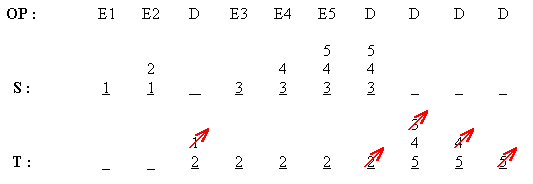Consider a sequence  of operations
of operations 
![]() e.g.
e.g.  is ins, del, or find in a BST.
is ins, del, or find in a BST.
If T(But is this the tightest bound?)
O( f( n ) )
Then
O( M f( n ) )
To 'amortize' means to pay off over time.Queue ExampleConsider a sequence
of operations

e.g.
is ins, del, or find in a BST.
If T(But is this the tightest bound?)
O( f( n ) )
Then
O( M f( n ) )
A FIFO queue supportsEnqueue( k )
and
k
Dequeue,
implemented with two stacks :exampleIntuition
Enqueue order : 1, 2, 3, 4, 5
Dequeue order : 1, 2, 3, 4, 5
Note that -
T( Enq )
O( 1 )
T( Deq )
O( n ), for n item in the queue
Let
,


What is T()?
Clearly, O(
)
- Each element is pushed once, transferred once, and popped once.Let
- So . . . T() is proportional to the number of elements that pass through the queue.
- So . . . T()
O( M )
be a sequence of operations.
Define the amortized time complexity,
, of operation
to be any function that satisfies
Intuition
 The Amortization Property
The Amortization Propertyis usually chosen as the 'smallest' function satisfying this property.
For any prefix of the sequence, the sum of the amortized costs is an upper bound on the true cost.Intuitionis the "average cost" of
in the context of the set
Since each element is pushed, transferred, and popped, we will "charge" each element for 3 time units when it is enqueued. Each time unit pays for one of push, transfer, or pop.Then
( Enq ) = 3. Since Dequeue uses only transfer and pop, which have already been 'charged for',
( Deq ) = 0. Note that the functions, and their costs, are arbitrary and specific to this example.
 Proof by InductionDo these amortized times satisfy the
Proof by InductionDo these amortized times satisfy theamortization property?
Yes!
Suppose it's true for k-1 operations :Therefore, if we choose
If
= Enq, then -
If





= Deq, then let -
e be the number of Enq in,
s be the size of S,
t be the size of T. Then -


( # push + # xfer + # pop ) + T(
)

( e + ( e - s ) + ( e - s - t ) ) + T(
)

( 3e - 2s - t ) + ( 1 + s )

3e + 1 - ( s + t )

3e
since s + t
1 ( i.e. queue not empty )








then we've proven that


and "the sum of the amortized costs is an upper bound on the actual cost."



O( M )
which is a better (tighter) bound than our earlier O(
)
But this, you may agree, is cumbersome. Here's an easier way . . .
Let each piece of data 'store' some (virtual) time credits. Each time credit 'pays for' a bounded-time operation on the piece of data. Operations are not charged if they use existing credits.Does this satisfy the property?








i.e. We can't use credits that we've not stored!
- Store two credits on an item when enqueing it.Back to index
- Use one when transferring.
- Use one when popping.Is
=
1 + 2 + 0
=
3

( supposetransfers s items )
= ( s + 1 ) + 0 - ( s + 1 )
where 's' : xfer and '1' : pop
= 0
?

Yes, since there are always 2 credits on items in S and 1 credit on items in T.